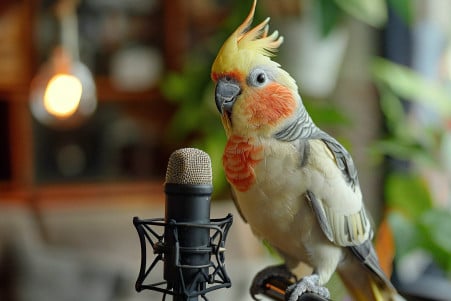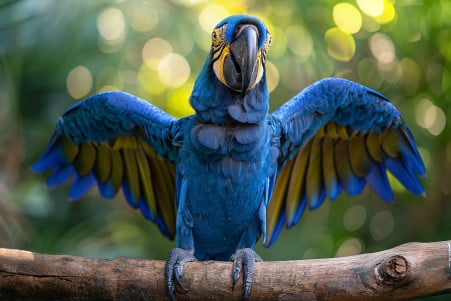Parrot Vocal Mimicry: The Science Behind Why Parrots Repeat Words
29 January 2024 • Updated 30 January 2024

Parrots are famous for their ability to talk, but why do they repeat human speech? Parrots are vocal mimics, and they use their ability to mimic sounds and words to form social bonds, whether it’s with their flock in the wild or their human companions in captivity. Their sophisticated vocal learning pathways enable them to learn sounds in context, a sign of their intelligence and flexibility.
In this in-depth look at parrots and their vocal mimicry, we draw on research from the fields of ethology, neurobiology, and cognitive science. This research sheds light on the evolutionary history of vocal mimicry, the social relationships within parrot groups, and the complex brain functions that make it possible for these birds to copy a wide range of sounds.
Together, these topics help us understand the many ways and reasons parrots mimic the sounds around them.
Why does my parrot mimic sounds and words from its environment?
Understanding the Evolution of Parrot Mimicry
Vocal mimicry in parrots, like that in songbirds, has evolved independently but is united by the common trait of vocal learning. A study of European passerines published in Behavioral Ecology provides some clues about the evolutionary importance of vocal mimicry. In parrots, vocal mimicry is more than just a way to imitate sounds; it’s a complex form of communication that’s tied to cognitive ability and potentially, even survival skills.
A study published in PubMed shows that vocal mimicry can be used for a variety of purposes, including deception, defense, and even to improve sexual displays. In parrots, these uses could help the birds in a variety of ways, from attracting mates to avoiding predators.
For example, a study covered by New Scientist shows that female superb lyrebirds are more attracted to males with a larger vocal repertoire, which may be a sign of greater intelligence and fitness.
Still, the full range of evolutionary advantages is not well understood, especially in the wild. However, as we learn more about these mysterious birds, the connection between mimicry and biological success is becoming clearer, and it may be tied to the intelligence of these avian mimics.
Social Learning and Parrot Mimicry
In addition to their impressive vocal abilities, parrots are highly social animals, and their social interactions have a profound impact on their ability to mimic. A study at Cornell University found that domesticated budgerigar parrots, or budgies, exhibit social learning in the brain. This study underscores the importance of parrots’ living situations, both in the wild and in captivity, in their ability to mimic.
Social interactions within parrot flocks are essential for communication, and mimicry can be used to direct calls at specific individuals, as research published in PLOS ONE has demonstrated. This shows that mimicry is more than just a way to copy sounds; it is a complex social tool within parrot communities that enables detailed communication networks.
The relationship between parrots and their human companions also influences mimicry. The daily care and emotional bonds that parrots form with humans are often reflected in their vocalizations, suggesting that mimicry may be used to strengthen these cross-species social bonds.
Moreover, the differences in mimicry between parrot species suggest that they have a wide range of vocal abilities that are shaped by their unique social and environmental circumstances. This flexibility in vocal mimicry indicates an underlying cognitive complexity and provides a foundation for future research into how targeted training can build on these innate skills.
How to Improve Your Parrot’s Ability to Talk: Training Methods for Better Mimicry
Parrots’ ability to mimic human speech is impressive, and there are a few training methods that can help you improve your parrot’s vocal skills. Two of the most popular are target training and clicker conditioning.
According to Bird Tricks, target training involves teaching a parrot to touch an object, such as a chopstick, with its beak. Clicker conditioning involves using a clicker to mark a desired behavior and then giving the parrot a treat. Both of these methods require consistency and positive reinforcement, which are two of the most important aspects of training a parrot.
Because parrots are natural mimics, it’s important to make sure that they are cognitively engaged during training. However, it’s also important to remember that parrots are also capable of learning and improving through structured exercises. Dr. Laurie Hess of Vetstreet says that this means that repetition and patience are key. She also says that you should reward your parrot for trying to mimic words, even if they only get part of the word right.
While these methods are generally recommended, it’s important to note that the success of training will depend on the individual parrot. Some parrots may quickly learn new words and phrases, while others may only make small improvements. However, with time and the right training, parrots can learn to mimic words and sounds more effectively as they learn to associate certain sounds with positive outcomes.
The Brain’s Impact on Parrot Vocal Mimicry
Parrots’ vocal abilities are unique in the animal world, and their vocal learning is closely tied to their brain structure. At the University of Alberta, neuroscientists found that parrots have an enlarged medial spiriform nucleus (SpM), a part of the brain that is equivalent to the pontine nuclei in primates. According to a report by Neuroscience News, this enlargement is linked to the birds’ complex behaviors and cognitive skills, including tool use and self-recognition.
Meanwhile, at Duke University, researchers delving deeper into the unusual structure of the parrot brain discovered a ‘core and shell’ song system in parrots. The ‘shell’ part of the system, which is unique to parrots, is especially large in species that are the best mimics. This complex system of brain regions enables parrots to take in auditory information and then reproduce it with great accuracy.
The cognitive demands of parrot vocal mimicry go beyond the ability to reproduce sounds and include the planning and execution of complex behaviors, which demonstrates the cognitive complexity of these birds.
Studies in Scientific Reports and PLOS ONE show that the size of these brain regions in relation to a parrot’s vocal learning ability suggests that their vocal learning may be as much a result of the evolution of their brains as their social interactions.
This connection between the brain and behavior shows the depth of parrots’ communication skills and raises questions about the broader implications of mimicry that go beyond the idea of simply repeating sounds.
Mimicry Matters: Why Parrots Mimic
In this article, we have delved into the evolutionary, social, and neurological factors that come together to enable parrots to mimic so effectively. We have seen that the roots of mimicry can be traced back to the evolutionary advantages seen in songbirds, where vocal learning and mimicry can help ensure survival and reproductive success, as well as the social dynamics of parrot flocks that help them develop their communication skills.
Yet, the importance of parrot mimicry goes beyond these factors. It can also be used to improve human-parrot relationships, allowing us to build stronger connections with our birds through training that is tailored to their cognitive abilities. In addition, the neurological and cognitive factors of parrot mimicry demonstrate the intelligence of these animals and the complex brain organization that underlies their vocal skills.
In summary, parrot mimicry is not just a fun talent; it is a way to understand the cognitive and social factors that drive animal behavior. It also shows the importance of interdisciplinary research in understanding animal intelligence, giving us the opportunity to not only understand why parrots mimic human speech but also the amazing abilities of the avian brain.


